|
|
|
Sort Order |
|
|
|
Items / Page
|
|
|
|
|
|
|
| Srl | Item |
| 1 |
ID:
138698
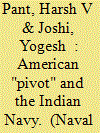

|
|
|
|
|
| Summary/Abstract |
Just after addressing the Shangri-La Dialogue in Singapore in June 2012, Leon Panetta, then the American secretary of defense, visited New Delhi, where he remarked that “defense cooperation with India is a lynchpin in this [pivot] strategy.” Since the thrust of the “pivot” has been on the maritime balance of power in the Indo-Pacific, both the Pacific and the Indian
Oceans have gained tremendous traction in the new U.S. strategy
|
|
|
|
|
|
|
|
|
|
|
|
|
|
|
|
| 2 |
ID:
133522
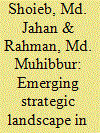

|
|
|
|
|
| Publication |
2014.
|
| Summary/Abstract |
The paper seeks to assess the growing strategic importance of the Bay of Bengal and how this signifies for Bangladesh's imperative to develop strong maritime capabilities. With the growing significance of the Bay of Bengal, both the littoral and the extra-littoral countries are reassessing their interests in this region and reformulating respective strategies to ensure optimum benefit in their favour. After the verdict by the International Tribunal for the Law of the Sea (ITLOS) in March 2012, Bangladesh is now able to establish its claim over a significant area in the Bay of Bengal. These emerging realities are driving Bangladesh to develop capabilities to project effective control over its maritime zone and to ensure sustainable utilisation of marine resources. To respond efficiently, Bangladesh government has undertaken various initiatives including modernisation of the Bangladesh Navy with an aim of establishing a three dimensional force. The paper, based on secondary literature, finds that there is a growing interest among the countries in the Bay of Bengal area leading to a competitive strategic atmosphere for countries like Bangladesh. The findings also suggest that Bangladesh's drive for maritime capability building is a timely and pragmatic step which requires further strengthening in the coming years. Besides, the paper also argues that Bangladesh needs to formulate a comprehensive maritime strategy, focusing on diverse sectors of capability building. Some key areas can include empowering the coast guard, resource exploration and exploitation capacities, maritime infrastructure development for connectivity and seaborne trade as well as well-coordinated maritime governance.
|
|
|
|
|
|
|
|
|
|
|
|
|
|
|
|
| 3 |
ID:
090981
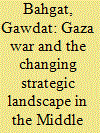

|
|
|
|
|
| Publication |
2009.
|
| Summary/Abstract |
On 27 December 2008, Israeli forces attacked Gaza to stop missile attacks by Hamas. The military operation lasted twenty-two days and ended with a fragile cease-fire. This study seeks to provide an assessment of all involved parties' stances. The author argues that some parties gained more than others, but the operation dealt a heavy blow to an already fragile peace process. Indeed, the Gaza war has further reinforced the current and growing polarization between the Palestinians and the Israelis. The continuing disagreement between the Palestinian factions and the election of a right-wing Israeli government suggest that the prospects for peace in the foreseeable future are dim.
|
|
|
|
|
|
|
|
|
|
|
|
|
|
|
|
| 4 |
ID:
151066
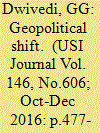

|
|
|
|
|
| Summary/Abstract |
In his book ‘World Order’, Henry Kissinger identifies four great world orders in history: European, Islamic, Chinese and American; each shaping the destiny of their nations, regions and the world at large as per respective agendas. While Europeans strived for bringing about balance in the international affairs; Islamic states pursued expansion; Chinese sought tributes to the Emperor; America perceived itself as the beacon to the world for universal values. While true world order has never existed, what prevailed over a period was devised at Westphalia almost four centuries back.
|
|
|
|
|
|
|
|
|
|
|
|
|
|
|
|
| 5 |
ID:
165055
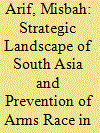

|
|
|
|
|
| Summary/Abstract |
South Asia is in part volatile because of the historical rivalry between India and Pakistan. After non-conventional and conventional military buildups in the past, an arms race in the domain of outer space is now a possibility. Space is an advantageous frontier for military uses. In this context, the consensus in international law defines space as a global commons to be used for peaceful purposes. Nonetheless, space powers, including India, engage in space militarization, which can lead to the weaponization of space. India is motivated in this regard by aspirations of regional hegemony and to balance its capabilities with respect to China in an effort to counter China’s increasing influence in South Asia. These developments posit adverse effects on the strategic equation in South Asia, leading to strategic instability, and can undermine nuclear deterrence and bring about a South Asian arms race in space. Moreover, the security dilemma in South Asia has prompted defensive and offensive reactions from rival states in the region, exacerbating repercussions on the South Asian strategic landscape. Analysis of the issues suggests that keeping space free from weaponization can alleviate strategic instability in South Asia.
|
|
|
|
|
|
|
|
|
|
|
|
|
|
|
|
|
|
|
|
|